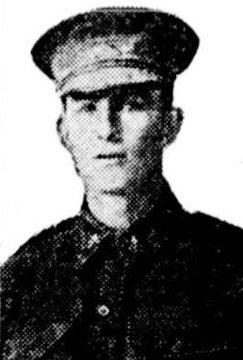Video Highlights - Don't Forget Me Cobber Lunch
Today's Honour Roll
| Name | Date of Death | Conflict |
|---|---|---|
| HODGE, Harold Frederick | 18 Oct 1917 | World War 1 |
| SIM, William Robert | 18 Oct 1917 | World War 1 |
| COLE, Walter Rivers | 18 Oct 1917 | World War 1 |
| DEER, Herbert | 18 Oct 1917 | World War 1 |
| DE VIS, Leslie Holmes | 18 Oct 1917 | World War 1 |
The Australian Red Cross Wounded and Missing Enquiry Bureau
The Australian Red Cross was founded in 1914, just 9 days after the start of the war, with state and local branches soon established across the country. Officially independent of government and military authorities, the Red Cross organised and conducted home front activities such as rolling bandages and sending comfort packages to soldiers, but this role soon expanded.
In October 1915, Miss Vera Deakin, daughter of ex-Prime Minister Alfred Deakin, established the Australian Red Cross Missing and Wounded Enquiry Bureau in Cairo. The Missing and Wounded Enquiry Bureau was founded to handle the many thousands of enquiries from Australian families seeking information on wounded and missing soldiers during the First World War.
Official Army information around the death of a soldier was often sadly lacking, particularly when the status of an individual was ‘missing in action’.
If a body was never found or identified, there was little the military could do. Official periodic enquiries into the status of the unlocated servicemen and women were held where evidence into the missing was assessed. After enquiry, most missing soldiers were pronounced killed in action.
Families could wait months or years for the release of official inquest results.
Many sought answers about the final hours and location of their loved ones. This desperate need for news prompted the Red Cross to form this Bureau to help families find out what had happened and fill in the gaps.
The work of the Bureau, run by volunteers, including nurses and members of the civilian-run Voluntary Aid Detachment, consisted of gathering witness statements of what had happened to those who had gone missing. Many of those involved in gathering these statements were also trained lawyers, as an understanding of the rules of evidence was a vital part of the role.
Red Cross workers collected statements in hospitals and casualty clearing stations behind the front lines, interviewing comrades of the missing and those who had seen them last. These accounts often revealed how a soldier had been struck down in battle or fatally wounded before vanishing from sight. As with all eyewitness testimony, details sometimes conflicted, but taken together they allowed the Bureau to piece together a final picture of a man’s last moments.
The search for information was exhausting work. Investigators moved through a maze of hospitals and camps, sometimes speaking with hundreds of men to find only a handful who had useful details. Yet for families at home, even the smallest fragments mattered.
As well as their work overseas, on the home front, the Red Cross set up "Information Bureaux" in each state capital city. Each bureau dealt with soldiers who had enlisted in their own state. However, there was close communication between all bureaux who assisted enquiries of soldiers enlisted elsewhere, including New Zealand.
Enquiries, which came from a number of sources, including family and loved ones, could come in person or via mail and would lead to a file being opened, and as soon as any information was received, it would be duly forwarded to the enquirer. Should the enquirer find the £1 cost of a cablegram and reply too expensive, the Red Cross would cover the costs. No other fees of any kind were charged to enquirers.

The records of these investigations have become one of the most valuable resources that we can use in historic research. In fact, around 32 thousand of these records are in possession of the Australian War Memorial and have been digitised here.
An example of a profile page with a Red Cross Missing file includes Wesley Frank WHITFIELD, who tragically died in Palestine in September 1918. His wife was initially only informed of his death without any details. But after contacting the Red Cross, enquiries were made, and his Red Cross records show that interviews with a number of fellow soldiers were conducted and that these detailed how he was seen shot in the neck by a German he was about to take prisoner. The interviews also detail his burial and that he was well liked by all. Providing this information to his widow allowed her to understand the loss of her husband and that he did indeed have a proper burial.
Another example is that of Frank Lawrence YOUNG from Victoria, who was killed in action in Ypres, Belgium, as part of the Battle of Polygon Wood, in October 1917. The accounts, including from close friends, in his Red Cross file state that he was seen killed by a shell. For his family, this provided the clarity denied by official reports.
Enquiries for information also came, for example, from the mother of George Burgess ADAM, who contacted the South Australian Red Cross office, enquiring about her son. Initially, only the details about his death at the hands of a sniper were discovered and passed on, but a few months later further details were established about George's burial behind the lines, and these were also sent on to his mother, providing that family with the answers to their questions.
There are many more examples for you to look through on the Virtual War Memorial. The records of all South Australian files are already linked on our profiles and can also be found in a database maintained by the State Library here.
In conclusion, the work of the Red Cross Wounded and Missing Enquiry Bureau provided important answers to the families of those whose fate was unclear. The work they undertook not only helped people grieving at the time but also produced important sources of information that we can use to this day to understand the historical facts.








Ensure we remember them always Make a Donation
Donors & Sponsors

News
The Human Cost
From the Boer War to Afghanistan, 103,101 Australian men and women have been killed serving their country.
Honour their service by:
- - Contributing to the profile of a serviceperson
- - Making a dedication on the page of a serviceperson
- - Giving generously to the VWMA to enable our work to continue
Help us keep the promise - We Will Remember Them All
How to Tell Your Story








